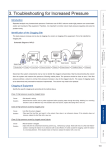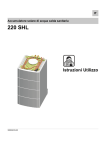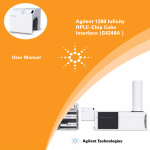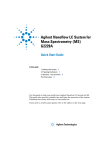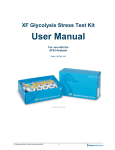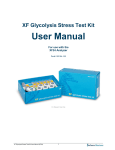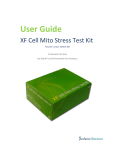Download - Agilent Technologies
Transcript
Agilent HPLC-Chip: G4240-61002 Infusion General Description: The G4240-62002 HPLC-Chip is designed to allow easy flow injection or direct infusion of the sample into the mass spectrometer. For use in flow injection mode reconfiguration of some capillary connections is required. The chip is connected to either the micro well plate autosampler (flow injection) or an external syringe pump (infusion) using stator valve port 3 of the HPLC-Chip cube and a 75 μm capillary and connection fittings. Once the capillary tubing connection is established, it is possible to perform sample infusion or flow injection at any time by simply inserting the Infusion Chip in the Chip Cube. Care & Use data sheet for the Infusion Chip. Scratches and other markings may be visible in the rotor area of the HPLC-Chip. Do not attempt to remove them. This is normal and occurs during the manufacturing final test. The appearance of additional scratches and markings in the rotor area following use of the HPLC-Chip is also normal and does not have any impact on chip performance. Maximum operating pressure for the HPLC-Chip is 150 bar (2175 psi). Safety Considerations All points of connection in liquid chromatographic systems are potential sources of leaks. Users of liquid chromatographic equipment should be aware of the toxicity or flammability of their mobile phases. Avoid use of mobile phases below pH 0.8 or above pH 8.0. Solvents with pH > 8.5 must not be used as they dissolve the quartz capillaries in the nano LC system and Chip Cube. Avoid touching the exposed polyimide surfaces of the HPLC-Chip. Do not manually extend the HPLC-Chip tip outside of the chip holder as this may result in tip damage and poor spray performance. Operational Guidelines Inspect the HPLC-Chip immediately upon its arrival. If there are any signs of damage, notify your local Agilent representative at once. Record the HPLC-Chip type and serial number, purchase date and operating limits. Keep a record of chip usage. This record will be invaluable in diagnosing HPLC-Chip problems. When not in use, always store the HPLC-Chip in a storage box to avoid dust or other foreign particle contamination. Special Considerations for use of the Infusion Chip The Agilent HPLC-Chip is specifically designed for use with the Agilent G4240A HPLC-Chip/MS Cube interface. Attempting to use the HPLC-Chip with other devices can damage the chip. General use of HPLC-Chips with the G4240A HPLCChip/MS Cube is described in the Chip Cube user manual, P/N G4240-90000. Descriptions for connection and precautions described here refer to this system. Special connection and operating requirements for the G4240-61002 Infusion Chip are described in this data sheet only. For more information on our products, visit the Agilent Technologies home page on the world wide web at http://www.agilent.com/chem/supplies For Technical Support in the US and Canada, call 1-800-227-9770 or call your local Agilent sales office Special Operational Guidelines for the Infusion Chip good flow rate to start with is 18 µL/h (equals 0.3 µL/min). For flow injection, switch the capillary pump to normal mode and set the flow rate to 0. The flow rate of the nano pump should be set to 0.3 µL/min and can be adjusted to give the best signal on the mass spectrometer. In both cases the flow rate should not exceed 1µL/min with recommended values around 0.3 to 0.6 µL/min. For infusion, manually start the run on the mass spectrometer. Please refer to your Agilent mass spectrometer operating manual for information on how to use and set up manual data acquisition. For flow injection, data acquisition will start automatically when the sample is injected by the micro well plate autosampler. Capillary Connections Infusion with Syringe Pump Plumbing Diagram for Infusion with Syringe Pump capillary pump flow sensor nano pump flow sensor syringe A Column Pressure. The very narrow I.D. capillaries used in the system for connections to the syringe pump, capillary pump and micro well plate sampler may occasionally plug despite the very smooth inner surface of such capillaries. It is good practice and strongly recommended to monitor and log the HPLC-Chip pressure regularly under standard conditions. In case there is a deviation of more than 10% from previously logged values, one of the transfer capillaries may be plugged. In such case, proceed as described in the chip care section. C E D 1 2 to waste 3 6 5 4 5 4 1 2 3 6 B chip cube valve µ-WPS valve Infusion Chip Care Fig. 1 Sample infusion with the syringe pump is similar to calibrant infusion and does not require changes to the standard plumbing shown in fig. 1. The sample is introduced via capillary C (75 µm, blue) into port 3 of the Chip Cube valve stator which connects directly to the emitter tip. If it is not installed, install this capillary now. For direct infusion of the sample, fill a 100 µL syringe with your sample and infuse at a flow rate of 18 µL/h. Make sure to flush syringe, capillary C and Infusion chip thoroughly with an appropriate solvent after use (e.g. 50/50 ACN/water). If solvent flow through the Infusion chip appears to be restricted (high pressure), check to see that solvent flow is unobstructed up to the HPLC-Chip inlet (connection capillaries). If replacing the connecting capillaries fails to restore flow through the chip, the chip most likely requires replacement. In order to protect your Infusion chip from overpressure conditions, set the maximum pressure limit of the nano pump to 150 bar. Flow Injection with µ-Well Plate Sampler The HPLC-Chip may be safely stored in most mobile phases. Agilent recommends to use a mixture of 50% acetonitrile and 50% water. Always flush out the Infusion chip with solvent and store it in a storage box to avoid dust or other foreign particle contamination. Plumbing Diagram for Infusion with Auto Sampler capillary pump flow sensor nano pump flow sensor syringe A C E 2 D 1 to waste 3 6 4 5 B µ-WPS valve 5 4 1 2 3 6 Infusion Chip Storage HPLC-Chip radio frequency identification tag The HPLC-Chip contains a radio frequency (RF) identification (ID) tag in the chip handle. The RF ID tag contains information on the HPLC-Chip layout. The information on the RF ID tag is automatically downloaded and updated by the system software from the HPLC-Chip Cube interface. Information stored on the chip RF ID tag: Product number Serial number# chip cube valve Revision Fig. 2 For flow injection, make the following modifications according to fig. 2: 1. Disconnect capillary E (50 µm, green) from port 1 of the µ-WPS valve. 2. Disconnect capillary A (15 µm, orange) from port 2 of the Chip Cube valve stator and reconnect it to port 1 of the µ-WPS valve. 3. Disconnect capillary C (75 µm, blue) from the Chip Cube valve stator and retract it into the guide tube to avoid damage to the end. 4. Disconnect capillary B (25 µm, yellow) on the Chip Cube side and reconnect it to port 3 of the Chip Cube valve stator. 5. The waste capillary D can remain connected to whatever port it is connected. Max. Pressure Limit Number of injections Time stamp of first usage Time stamp of last usage Total time in operation User comment field Your system is now ready to perform flow injection simply by inserting the G424061002 Infusion Chip in to the Chip Cube. To revert to normal operation with analytical HPLC-chips, perform the above steps in reverse order. Flow rate. When performing infusion with a syringe, switch both nano pump and capillary pump to normal mode and set the flow rates to 0. Set the syringe pump to a flow rate that gives you the best signal on the mass spectrometer. A *G4240-90202* *G4240-90202* G4240-90202 Part Number: G4240-90202 Edition 12/ 2005 Printed in Germany © Agilent Technologies, Inc. 2005 Agilent Technologies Hewlett-Packard-Strasse 8 76337 Waldbronn, Germany


